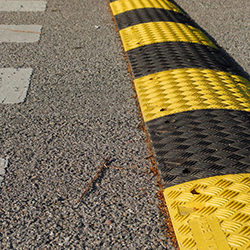Speed bumps are physical traffic calming devices designed to slow down vehicles in specific areas, such as residential neighborhoods, school zones, or parking lots. They are typically raised sections of pavement strategically placed to reduce vehicle speed and enhance safety for pedestrians and drivers.
The importance of high-quality speed bumps cannot be overstated when it comes to safe and efficient traffic management. In this article, we will explore the key characteristics that define high-quality speed bumps, the different types available, the benefits they offer, proper installation and maintenance practices, and real-life examples of successful implementations.
What makes a speed bump high-quality?
High-quality speed bumps possess certain key characteristics that set them apart from standard speed bumps. These criteria ensure effectiveness, durability, and enhanced safety:- Durability: High-quality speed bumps are made of durable materials that can withstand heavy traffic and varying weather conditions.
- Visibility: They are brightly colored or marked with reflective materials to ensure visibility, especially during nighttime or adverse weather.
- Height and slope: Proper height and slope are crucial to effectively slow down vehicles without causing discomfort or damage.
Types of high-quality speed bumps
There are several types of high-quality speed bumps designed to effectively slow down vehicles and enhance safety on roads:- Speed humps: Speed humps are raised sections of pavement that span the width of the road, forcing drivers to slow down. They are effective in residential areas and parking lots.
- Speed tables: Speed tables are longer and flatter than speed humps, providing a more gradual change in elevation. They are often used near schools and pedestrian crossings.
- Speed cushions: Speed cushions are narrower than speed humps and allow wider vehicles, such as emergency vehicles, to pass without slowing down. They are commonly used on streets with regular emergency vehicle traffic.
Benefits of high-quality speed bumps
High-quality speed bumps offer a range of benefits that contribute to safe and efficient traffic management:- Improved safety for pedestrians and drivers: Speed bumps help create safer environments by reducing the risk of accidents involving pedestrians and vehicles.
- Reduced vehicle speed: By forcing vehicles to slow down, speed bumps decrease the likelihood of high-speed collisions, minimizing the severity of accidents.
- Lower accident rates: The presence of speed bumps has been linked to a decrease in the number of accidents, particularly in areas with high pedestrian or vehicle traffic.
- Benefits for emergency vehicles: Well-designed speed bumps, such as speed cushions, allow emergency vehicles to navigate through traffic smoothly while still maintaining traffic calming effects.
- Positive impact on traffic flow and neighborhood safety: Speed bumps help regulate traffic speed, improve road safety, and promote a sense of community well-being in residential areas.
Installation and maintenance of high-quality speed bumps
Proper installation and maintenance of high-quality speed bumps are essential for ensuring their effectiveness and longevity in enhancing traffic safety:- Importance of proper installation: Correct installation techniques guarantee that speed bumps function as intended, maintaining optimal traffic calming effects.
- Common mistakes to avoid: Errors such as improper placement, incorrect dimensions, or inadequate signage can diminish the efficacy of speed bumps and compromise road safety.
- Routine maintenance to ensure effectiveness and longevity: Regular inspections, repairs, and cleaning help preserve the condition of speed bumps, ensuring they remain visible, functional, and safe for road users.
- Cost considerations for installation and maintenance: Factoring in the initial installation costs and ongoing maintenance expenses is crucial for budget planning and long-term sustainability of speed bump projects.
Real-life examples of high-quality speed bumps
Several cities and locations have successfully implemented high-quality speed bumps, showcasing their positive impact on traffic safety:- City A: In City A, the installation of durable and visible speed bumps along residential streets led to a significant decrease in speeding violations and a notable improvement in pedestrian safety.
- City B: City B strategically placed speed humps near schools and parks, resulting in a noticeable reduction in vehicle speeds and a lower rate of accidents in these high-risk areas.
- City C: By introducing speed cushions on busy urban roads, City C experienced a substantial decline in traffic-related injuries and an overall enhancement in road safety for both drivers and pedestrians.

